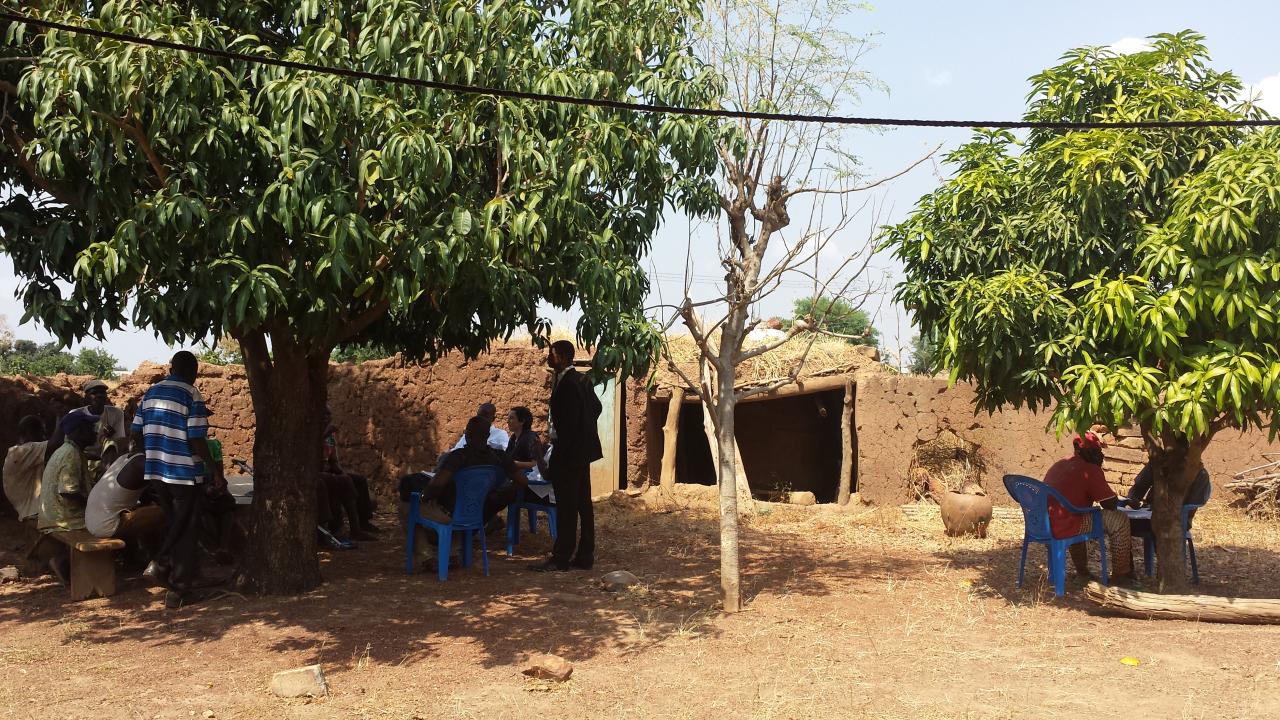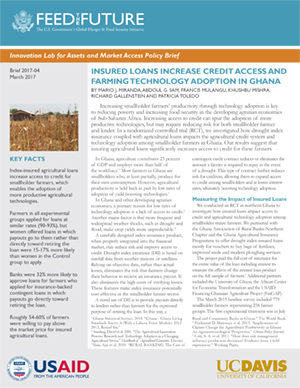
Increasing smallholder farmers’ productivity through technology adoption is key to reducing poverty and increasing food security in the developing agrarian economies of Sub-Saharan Africa. Increasing access to credit can spur the adoption of more productive technologies, but may require reducing risk for both smallholder farmer and lender.
In a randomized controlled trial (RCT), we investigated how drought index insurance coupled with agricultural loans impacts the agricultural credit system and technology adoption among smallholder farmers in Ghana. Our results suggest that insuring agricultural loans significantly increases access to credit for these farmers.
Highlights
- Index-insured agricultural loans increase access to credit for smallholder farmers, which enables the adoption of more productive agricultural technologies.
- Farmers in all experimental groups applied for loans at similar rates (90-93%), but women offered loans in which payouts go to them rather than directly toward retiring the loan were 15-17% more likely than women in the Control group to apply.
- Banks were 32% more likely to approve loans for farmers who applied for insurance-backed contingent loans in which payouts go directly toward retiring the loan.
- Roughly 54-60% of farmers were willing to pay above the market price for insured agricultural loans.
In Ghana, agriculture contributes 23 percent of GDP and employs more than half of the workforce.[1] Most farmers in Ghana are smallholders who, at least partially, produce for their own consumption. However, agricultural productivity is held back in part by low rates of adoption of yield-boosting technologies.[2]
In Ghana and other developing agrarian economies, a primary reason for low rates of technology adoption is a lack of access to credit.[3] Another major factor is that more frequent and widespread weather shocks, such as drought and flood, make crop yields more unpredictable.[4]
A carefully designed index-insurance product, when properly integrated into the financial market, may reduce risk and improve access to credit. Drought index insurance (DII) is based on rainfall data from weather stations or satellites. Relying on objective data, rather than actual losses, eliminates the risk that farmers change their behavior to recieve an insurance payout. It also eliminates the high costs of verifying losses. These features make index insurance potentially cost-effective in the smallholder farmer sector.
A novel use of DII is to provide payouts directly to lenders rather than farmers for the expressed purpose of retiring the loan. In this way, a contingent credit contract reduces or eliminates the amount a farmer is required to repay in the event of a drought. This type of contract further reduces risk for creditors, allowing them to expand access to credit among smallholders and at lower interest rates, ultimately boosting technology adoption.
Measuring the Impact of Insured Loans
 We conducted an RCT in northern Ghana to investigate how insured loans impact access to credit and agricultural technology adoption among smallholder maize farmers. We partnered with the Ghana Association of Rural Banks-Northern Chapter and the Ghana Agricultural Insurance Programme to offer drought index-insured loans mostly for vouchers to buy bags of fertilizer, improved seeds and modern ploughing services.
We conducted an RCT in northern Ghana to investigate how insured loans impact access to credit and agricultural technology adoption among smallholder maize farmers. We partnered with the Ghana Association of Rural Banks-Northern Chapter and the Ghana Agricultural Insurance Programme to offer drought index-insured loans mostly for vouchers to buy bags of fertilizer, improved seeds and modern ploughing services.
The project paid the full cost of insurance for the entire value of the loan including interest to measure the effects of the insured loan product on the full sample of farmers.[5] Additional partners included the University of Ghana, the African Center for Economic Transformation and the USAID Financing Ghanaian Agriculture Project (FinGAP).
The March 2015 baseline survey included 779 smallholder farmers representing 258 farmer groups. The first experimental treatment was in July 2015, with the midline survey in March 2016 and a second experimental treatment in July 2016. The final survey takes place in March 2017. Farmers were randomly assigned to one of three groups:
- Microinsured: offered production loans coupled with index insurance that directs payouts to the borrower (farmer).
- Mesoinsured: offered production loans coupled with index insurance that directs payouts to the lender for the expressed purpose of paying back the loan.
- Control: offered loans without index insurance.
Payouts to Lenders Increase Approvals
We conducted a difference-in-differences analysis to identify whether insured loans increase credit access. This method and the randomization of farmers into the three groups allowed us to isolate the estimated impact for each treatment from unrelated influences on credit access.
Farmers in all three groups applied for agricultural credit at similar rates (90-93%), suggesting the treatments had a minimal average impact on farmers’ demand for agricultural loans. However, we found that women in the Microinsured group were between 15 and 17 percent more likely than women in the Control group to apply for loans.
Compared to the Control group, we found no significant difference in approval rates for farmers in the Microinsured group. However, banks were 32 percent more likely to approve loans for farmers in the Mesoinsured group who were offered insurance-backed contingent loans.
This higher approval rate could mean that banks perceive a lower risk when payouts go directly to repaying the loan. We detected this increase for both men and women, though the likelihood of approval was 36 percent for men and 30 percent women.
Market Viability of Insured Loans
In addition to the RCT, we used a contingent valuation approach to estimate farmers’ willingness-to-pay for agricultural loans insured with drought index insurance. We included the willingness-to-pay questions in the baseline and midline surveys. This farmer-reported valuation lets us estimate hypothetical differences in demand for insured loans depending on whether payouts go to farmers or lenders.
These estimates indicate that roughly 60 percent of farmers were willing to pay above the market price for a Microinsured loan while 54 percent were willing to pay above market price for a Mesoinsured loan.
Across both insured groups, financial inclusion and education were both associated with higher demand for insured loans. Higher risk aversion among farmers decreased demand for these loans. Prior experience with insured loans showed no impact on willingness-to-pay for either group.
Policies to Increase Access to Credit
Barriers to technology adoption, such as limited access to credit and environmental risk, must be overcome to meet growing demand for food across developing agrarian economies. Our analysis suggests that index-insured agricultural loans increase credit access, which enables smallholder farmers to adopt more productive technologies.
Several challenges remain. First, basis risk remains a barrier to demand for index-insured loans, as payouts may not cover actual losses. Second, although contingent credit loans most effectively increased credit supply, this loan had the lowest demand in our willingness-to-pay survey. While 73 percent of our sample borrowed in 2014, only 54 percent reported willingness to pay market value for insured loans. This leaves a dilemma: do banks make insurance mandatory or do they offer a choice of insured or uninsured loans?
By making insurance mandatory, banks more effectively protect their portfolios but reduce the number of borrowers. By giving the choice to farmers, those with lower wealth, lower education and higher risk aversion would more likely choose an uninsured loan and thus would be more likely to default on the loan in the case of a drought.
Mario J. Miranda is a professor of agricultural, environmental and development economics at The Ohio State University.
Abdoul G. Sam is an associate professor of agricultural, environmental & development economics at The Ohio State University.
Francis Mulangu is an economist at the Millennium Challenge Corporation.
Khushbu Mishra and Richard Gallenstein are Ph.D. candidates in agricultural, environmental & development economics at The Ohio State University.
Patricia Toledo is an assistant professor of economics at Ohio University.
[1] Ghana Statistical Service. 2014. “Ghana - Ghana Living Standards Survey 6 (With a Labour Force Module) 20122013, Round Six.”
[2] Sunding, David et al. 2001. “The Agricultural Innovation Process: Research and Technology Adoption in a Changing Agricultural Sector.” Handbook of Agricultural Economics. Elsevier.
[3] Nair, Ajai et al. 2010. “RURAL BANKING: The Case of Rural and Community Banks in Ghana.” The World Bank.
[4] Ferdinand D. Mawunya et al. 2013. “Implications of Climate Change for Agricultural Productivity in Ghana: An Agrometeorological Perspective.” Ghana Policy Journal.
[5] Cole, S. A. et al. 2011. “How does risk management influence production decisions? Evidence from a field experiment.” Working Paper.
This report is made possible by the generous support of the American people through the United States Agency for International Development (USAID). The contents are the responsibility of the Feed the Future Innovation Lab for Assets and Market Access at UC Davis and do not necessarily reflect the views of USAID or the United States Government.
